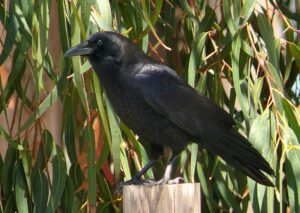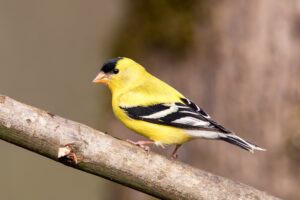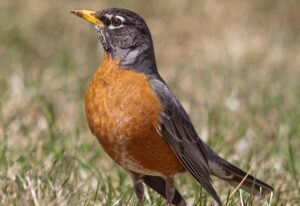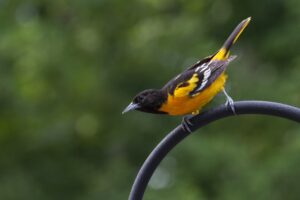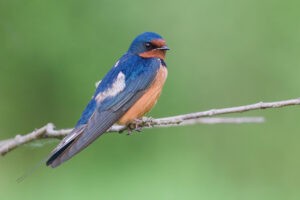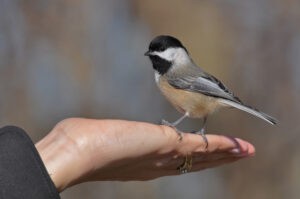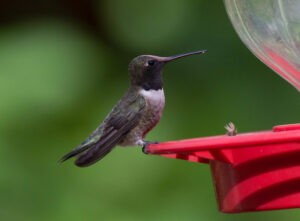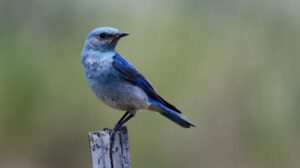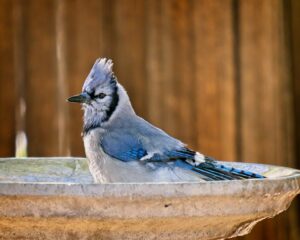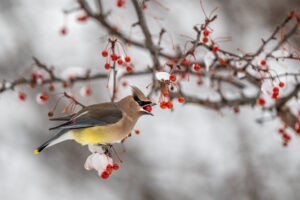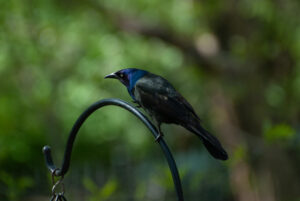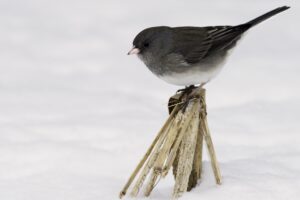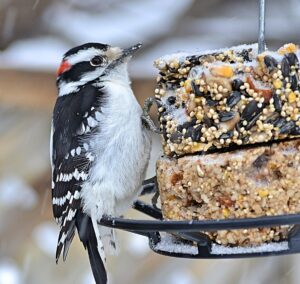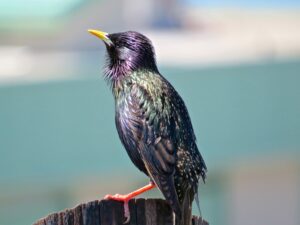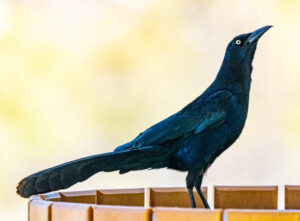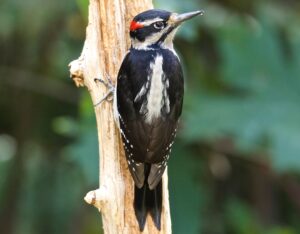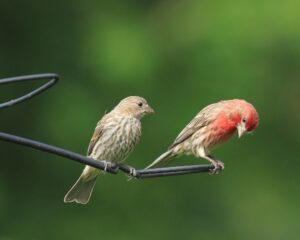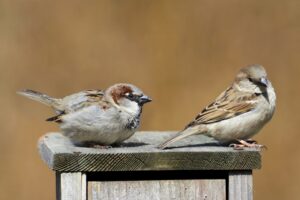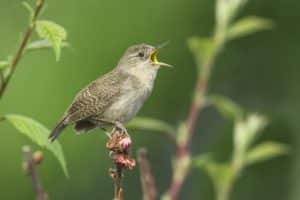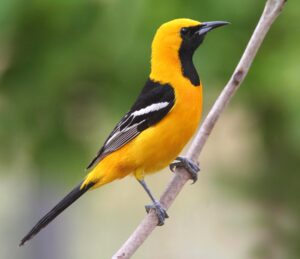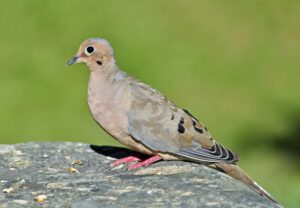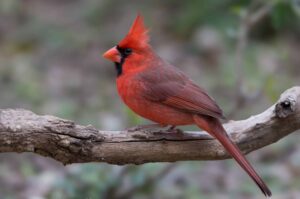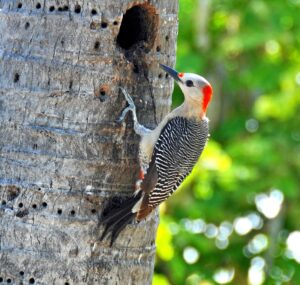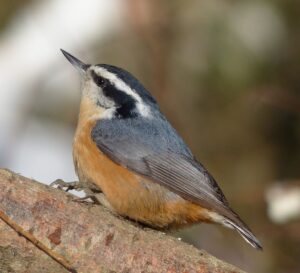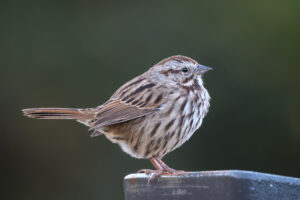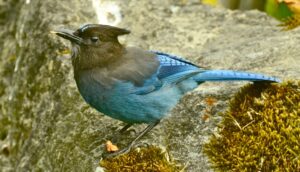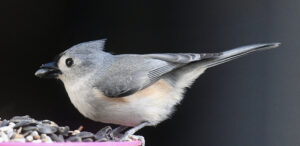Are you interested in birds but can’t identify them very well? Or do you know them on sight but would like to learn something about them? Here, in alphabetical order, are twenty-seven of the most widespread and beloved backyard birds and the foods they like. Put out some of their favorite seeds, and they’ll want to stay around.
Birds are fascinating, adding beauty and vitality to our yards. Their colorful plumage, melodic songs, and captivating behaviors provide relaxation and stress relief. They also foster a deeper connection to the natural world. (Provide the basic needs of wildlife to encourage them to stay)
(Thank you to the talented photographers whose beautiful photos enhance the pages on this site. Acquiring large numbers of photos is cost-prohibitive for a small site such as this, but they offer their images for free under Creative Commons Licenses or in the public domain. This allows us to provide informative content paired with captivating visuals.)
American Crow, Corvus brachyrhynchos
An American Crow, the recognized smartest bird in the world, commands attention by its large size of 16 to 21 inches (40–53 cm) and raucous call. They’re opportunistic feeders with a diverse diet, including insects, small mammals, carrion, and agricultural crops. You may be able to attract them to your yard with corn, peanuts, or sunflower seeds placed in open spaces. They form large social groups and exhibit cooperative behaviors such as mobbing predators or sharing information about food sources. Their range spans from southern Canada to northern Mexico
American Goldfinch, Spinus tristis
Beautiful American Goldfinches measure 5 to 6 inches (12.7–15.2 cm) long. In the summer, the male is easily recognized by his bright yellow plumage and black wings marked by striking white patches. They feed on the seeds of weeds, grasses, and trees with small seeds, such as elm, birch, and alder. They also eat buds, tender bark, and maple sap. Thistle is a favorite, and they’ll visit feeders for that and sunflower seeds. Native to N.A., they have a wide range of habitats from southern Canada to northern Mexico, with a preference for fields, meadows, and open urban areas.
American Robin, Turdus migratorius
A beloved and iconic bird known for its distinctive orange-red breast and grayish-brown plumage, who doesn’t love American Robins? They measure around 9 to 11 inches (23–28 cm) in length. Their cheerful song and habit of hopping along lawns in search of food marks the arrival of spring in many regions. Skilled foragers, they feed on a diverse diet of insects, earthworms, berries, and fruits. Not commonly associated with bird feeders, they still may visit for mealworms, especially during harsh weather or scarcity of natural foods. And they love a birdbath, any time of year. They inhabit woodlands, gardens, parks, and suburban and urban areas across a vast range that extends from Alaska and Canada down to Mexico.
Baltimore Oriole, Icterus galbula
The Baltimore Oriole is a strikingly colorful songbird, with males sporting bright orange plumage accented by black and white markings, while females exhibit a more subdued yellow hue. Typically measuring around 7 to 8 inches (18–20 cm) in length, these birds have a slender build and a distinctive pointed beak. They feed primarily on insects, nectar, and fruit, showing a particular fondness for ripe berries and oranges. While they’re not regular visitors to bird feeders, offering sliced oranges or grape jelly can attract them, especially during migration or breeding seasons. Their range extends across eastern N.A., from Canada to the Gulf Coast, in a variety of habitats, including forests, orchards, and gardens. Although they prefer wooded areas, they’ll inhabit urban and suburban environments with suitable food sources and nesting sites.
Barn Swallow, Hirundo rustica
Measuring 6.7 to 7.5 inches (17–19 cm) long, Barn Swallows are known for their distinctive forked tail and vibrant plumage. Their name originates from nesting in barns and other human-made structures, including urban porches, where they construct a cup-shaped nest out of mud and straw. These birds are adept fliers, often seen darting and swooping through the air with their bills wide open to catch insects on the wing. They will sometimes come to ground-up eggshells or oyster shells placed on an open platform feeder. A source of mud for their nest-building also helps to attract them. They have a vast range, breeding across most of Canada and all the Americas, as well as Europe, Asia, and Africa. Their preferred habitats are fields, parks, marshes, meadows, ponds, cities, and coastal waters. They migrate to warmer regions during the winter.
Black-capped Chickadee, Poecile atricapillus
These delightful birds, 4.5 to 5 inches (11–13 centimeters) long, have a distinctive black cap and bib, white cheeks, and grayish wings and back. They often flit about in trees and bushes, hanging upside down or clinging to branches while foraging for food. They feed on insects, seeds, and berries and frequently visit bird feeders, particularly those stocked with sunflower seeds, suet, or peanut butter. They’re found across southern Canada and the northern half of the U.S., including Alaska. Highly adaptable, they inhabit forests, woodlands, parks, and suburban and urban areas with suitable habitats. They cache food in various locations during the fall and winter months to sustain themselves when food becomes scarce.
Black-chinned Hummingbird, Archilochus alexandri
The Black-chinned Hummingbird is only 3.5 to 4 inches (8.9–10.2 cm) long. Its name originates from the narrow strip of black feathers adorning its throat that shimmer purple in the light. Despite their small size, they display remarkable territorial behavior, fiercely defending feeding territories from intruding hummingbirds. They feed primarily on flower nectar but supplement their diet with small insects and spiders. They readily visit hummingbird feeders for nectar. Nectar recipe Their range extends from the western U.S. to parts of Mexico, encompassing a variety of habitats such as woodlands, deserts, and gardens. During migration, they may travel up to 2,000 miles (3,200 km) between their U.S. breeding grounds and wintering range in Mexico and Central America. Hummingbirds that migrate 1000s of miles
Bluebirds, Sialia spp.
Bluebirds are small birds around 6.5 to 7 inches (17–18 cm) in length. Their striking blue plumage is what catches the eye. They primarily feed on insects, including beetles, grasshoppers, and caterpillars; also berries and fruits, especially in the winter when insects are scarce. They’re among the few bird species that can spot and catch insects while flying from their perches. Entice them to bird feeders with mealworms or suet. Three species of bluebirds are native to the U.S. Each is named for the range it inhabits: the Eastern, the Western, and the Mountain. They’re typically associated with open habitats such as fields, meadows, and orchards but can also be found in suburban and urban areas where suitable nesting sites and food sources are available.
Blue Jay, Cyanocitta cristata
These bold and beautiful birds, around 9 to 12 inches (23–30 cm) long, have vibrant blue plumage with white underparts and black markings on their wings and tail. They have a varied diet that consists of nuts, seeds, insects, fruits, and sometimes small vertebrates. They’re frequent visitors to bird feeders, where they eagerly consume peanuts, sunflower seeds, and suet. Their range extends across much of eastern and central N.A. from southern Canada to Florida and Texas. Blue Jays are highly adaptable and thrive in various habitats, including forests, woodlands, parks, and suburban and well-wood city areas.
Cedar Waxwing, Bombycilla cedrorum
This elegant songbird is known for its silky plumage and distinctive wax-like red tips on its secondary feathers. Measuring 6.5 to 7 inches (16.5–17.8 cm) in length, their name derives from their taste for cedar berries. They eat other berries, too, including Winterberry, hawthorn, crabapple, serviceberry, strawberry, mulberry, dogwood, mountain ash, elderberry, raspberry, and others. They also consume insects, flower petals, and occasionally sap. Their range spans across N.A., from southern Canada to parts of Mexico, in a variety of habitats, including woodlands, orchards, and suburban areas. They’re increasingly coming into cities; to attract them add several berry-producing plants to your yard.
Common Grackle, Quiscalus quiscula
A medium-sized bird measuring 11 to 13 inches (28–33 cm) long, Common Grackles have glossy black plumage with striking iridescent blue or purple hues visible in sunlight. Known for their raucous calls and gregarious behavior, they often form large, noisy flocks, especially during migration and winter. They’re omnivorous and opportunistic feeders with a diet that includes insects, seeds, grains, fruits, and small vertebrates. They readily consume suet, cracked corn, and sunflower seeds at feeders. Their range spans across much of N.A., from southern Canada to Central America, where they inhabit a variety of habitats, including forests, wetlands, grasslands, and urban and suburban areas. Fun fact: They’re known for their synchronized flock movements, especially during migration, that create mesmerizing aerial displays.
Dark-eyed Junco hyemalis
These distinctive birds, about 5 to 6 inches (13–15 cm) long, exhibit varying coloration depending on their geographic location. They’re typically slate-gray with white underparts and pink bills but can also vary from brownish-gray to reddish-brown. They forage on the ground or in low vegetation and primarily feed on seeds, insects, and occasionally fruits. They’ll consume millet, cracked corn, and sunflower seeds on platforms or the ground. Their range spans across N.A., from Alaska to Mexico, in a variety of habitats, including forests, grasslands, and suburban areas. Those in northern locations move south in the winter.
Downy Woodpecker, Picoides pubescens
Small, around 5 to 6 inches (13–15 cm) long, and the smallest woodpeckers in N.A., they have black and white plumage with distinct markings. Males sport a small red patch on the back of their heads. Known for their agile climbing abilities and distinctive drumming sounds, they often forage on tree trunks and branches, probing for hidden insects. Frequent visitors to feeders, they eagerly consume suet, peanuts, and sunflower seeds.
Their range spans across N.A., from Alaska to Florida, in forests, woodlands, parks, and urban and suburban areas.
European Starling, Sturnus vulgaris
Glossy black feathers speckled with iridescent purple and green hues and spots of white and a body length of 8 to 9 inches (20–23 cm) identify a European Starling. And it’s never alone. They’re omnivorous feeders that arrive in flocks and consume a varied diet of insects, fruits, seeds, and even garbage. They may occasionally visit feeders with suet, mealworms, and various seeds. Their range extends across much of Europe, Asia, and N.A. They’re highly adaptable and found in urban and suburban areas, where they nest in cavities and crevices of buildings and trees. Particularly during migration, they form enormous flocks that perform dazzling displays of aerial mastery called murmurations.
Great-tailed Grackle, Quiscalus mexicanus
Large, around 16 to 18 inches (41–46 cm) long, with glossy black plumage and a long, distinctive tail (and males with striking yellow eyes), Great-tailed Grackles rule their domain. Omnivorous, they feed on a wide variety of foods, including insects, fruits, seeds, grains, and even small vertebrates. They may occasionally visit feeders for cracked corn, sunflower seeds, or suet. They range from the southwestern U.S. down through Central America into northern South America. They’re found in diverse habitats such as grasslands, wetlands, agricultural areas, city parks, and yards with an open expanse.
Hairy Woodpecker, Leuconotopicus villosus
The Hairy Woodpecker is 7 to 10 inches (18 –25 cm) long. Larger than the Downy Woodpecker, it has black and white plumage with distinct markings; males can be identified by a small red patch on the back of their head. Both species are often seen in the same habitat. They feed primarily on insects, particularly beetles, ants, and larvae, but may occasionally be drawn to feeders with suet, peanuts, and sunflower seeds. They range across much of N.A., from Alaska to Florida, in forests, woodlands, parks, and yards with large trees. They’re named for the fine, hair-like feathers on their bill.
House Finch, Haemorhous mexicanus
Small birds about 5 to 6 inches (13–15 cm) in length, House Finches have brownish-gray plumage with streaks on their undersides. Males have distinctive red patches on their heads and breasts. They forage for seeds, grains, fruits, and occasionally insects on the ground or in low vegetation and will readily visit feeders for sunflower seeds, millet, and cracked corn. Native to the Southwest, House Finches are found across much of N.A., from Canada to Mexico. They’re common in suburban and urban areas with lawns, weedy areas and trees, and buildings they can nest in. Some northern residents migrate south in the fall.
House Sparrow, Passer domesticus
House Sparrows are 5 to 6 inches (13–15 cm) long, with brown plumage and grayish undersides. Males have a distinct black marking on their throat. They feed primarily on seeds, grains, and food scraps, foraging on the ground or in bushes and trees. Millet, sunflower seeds, and cracked corn will draw them to feeders. Native to Eurasia and Africa, House Sparrows are now found worldwide, from farms to cities, always near human-made structures.
House Wren, Troglodytes aedon
Small, only about 4.5 inches (11.4 cm) long, House Wrens are brown, with short wings, a long, curved beak, and tail feathers they cock up at a jaunty angle or sometimes slightly droop. Their name originates from their habit of nesting in various human-made structures, including birdhouses and buildings. Despite their size, they have a loud voice, which they use to attract mates and establish territory boundaries. They have a varied diet that includes insects, spiders, and occasionally small fruits and seeds. They aren’t tempted by feeders, so put up a wren house. They’re the most widespread native bird in the Americas, extending from Canada to Argentina, and inhabit woods, thickets, and gardens everywhere.
Hooded Oriole, Icterus cucullatus
The vibrant plumage of the male won’t be ignored! Hooded Orioles are 7 to 8 inches (17.8–20.3 cm) long, with males adorned in bright orange-yellow hues and a distinct black hood; the female exhibits a more subdued yellow-green coloration. They use their slender, curved bill to extract nectar from flowers and to capture insects in mid-air or glean them from foliage. They’ll visit feeders with orange slices and grape jelly. Native to the southwestern U.S. and parts of Mexico, they like open woods, palms, and shade trees, such as cottonwood, walnut, and sycamores in urban locales.
Mourning Dove, Zenaida macroura
They’re well known for their gentle and mournful cooing calls, often heard in the early morning and evening hours. Mourning Doves, 12 inches (30 cm) long, possess a delicate appearance with soft, muted plumage featuring shades of gray and beige. They prefer to feed on the ground, primarily on seeds, grains, and occasionally small insects. To attract them to feeders, use a platform or large hopper feeder with white millet, safflower, oil sunflower, or cracked corn. Found from southern Canada to central Mexico, they inhabit farmlands, woodlands, open fields, and urban yards. Some in northern areas migrate south in the fall.
Northern Cardinal, Cardinalis cardinalis
Does anyone not recognize the male Northern Cardinal? About 8 to 9 inches (20.3–22.9 cm) in length, he’s adorned in brilliant red feathers. The female displays a more subdued brownish-red hue with touches of red. A beautiful pair! They’re primarily seed-eaters with a diet consisting of various seeds, fruits, and insects. At bird feeders, offer them sunflower and safflower seeds and peanut bits. Their range spans most of the eastern half of the U.S., from southern Canada to northern Mexico, with some populations established in Central America. Northern Cardinals are commonly found in diverse habitats such as woodlands, parks, and suburban and urban areas with dense bushes for nesting.
Red-bellied Woodpecker, Melanerpes carolinus
Around 9 to 10 inches (22.9–25.4 cm) long, Red-bellied Woodpeckers have a bold black-and-white striped back and a dull grayish belly with a reddish tint. Males have a bright red cap from their forehead to the base of their neck, and females have red only on their neck. They’re omnivores and feed on insects, fruits, nuts, and seeds. Suet, peanuts, sunflower seeds, and cracked corn will draw them to feeders.
Native to the eastern half of the U.S., from southern Canada to the Gulf Coast, they favor forests, woodlots, and urban and suburban areas with mature trees.
Red-breasted Nuthatch, Sitta canadensis
A series of “yank-yank” calls announces that a Red-breasted Nuthatch is around, even if out of sight. They’re 4.5 to 4.75 inches (11-12 cm) long, with a black-and-white striped head, red-orange breast, and blue-gray upperparts. Look for them foraging upside-down along tree trunks and branches as they search for food. They mainly eat insects and spiders but also seeds, especially those of conifers. At feeders, they’ll eat sunflower seeds, nuts, and suet. They span N.A., spending their summers in Canada and winters across the U.S. They visit suburban and urban yards with mature trees, especially those with some conifers.
Song Sparrow, Melospiza melodia
Among the most familiar U.S. sparrows, Song Sparrows are 5.5 to 7 inches (14–18 cm) long, with russet stripes, a striped face, and streaks on the breast that often converge into a central spot. They feed on insects, spiders in the summer, and seeds and fruits year-round, and will come for millet at feeders on the ground. A native species, they inhabit grasslands, marshes, forests, and suburban and urban areas across N.A., from Canada to Mexico, and prefer thick growth, often hiding within it. Many spend their summers in Canada.
Steller’s Jay, Cyanocitta stelleri
Steller’s Jays are 11 to 12 inches (27.9–30.5 cm) long, larger than many other jay species. They have vibrant blue plumage with black markings and a prominent crest atop their heads. They’re omnivorous, eating insects, small vertebrates like lizards and nestlings, and seeds, nuts, and berries. Attract them to feeders with peanuts or other large nuts and suet. They’re native to western Canada, the western U.S., and south to Chile. They like mixed, hardwood, and coniferous forests, including those in suburban and urban areas.
Tufted Titmouse, Baeolophus bicolor
The Tufted Titmouse is 6 to 7 inches (15.2 to 17.8 cm) long. The “titmouse” part of its name comes from the Old English word “tit,” meaning small, and “mouse,” referring to its foraging behavior, akin to a mouse scurrying around. (The plural for titmouse is titmouses or titmice.) They feed primarily on insects and spiders but also seeds, nuts, and berries. Attract them to feeders with sunflower seeds. Their range spans eastern and central N.A., from southern Canada to northern Florida and westward to the Great Plains. They inhabit deciduous woods, parks, and wooded suburban and urban yards
Native flowering plants for pollinators, birds
Types of bird feeders
Cornell Lab: The 4 keys to bird identification
Tree facts: marvel at their wonders



